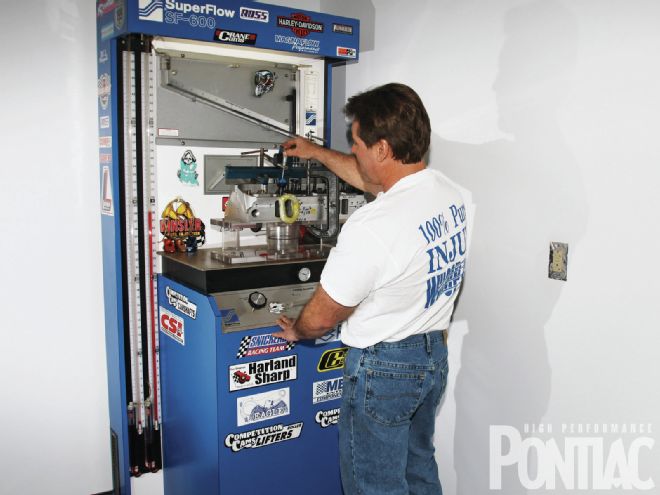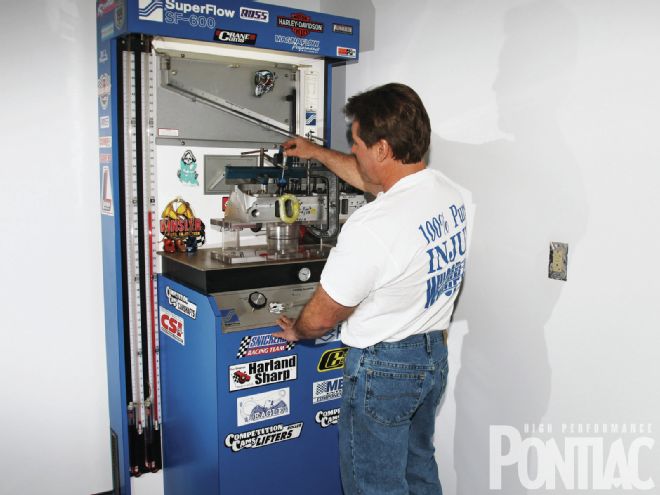
In the Feb. ’11 issue of HPP, we presented the new Edelbrock Performer D-Port head in the article D-Port Development. At the time, the head wasn’t production ready, so our story was written based on the prototype we obtained. The heads have since gone into production and have reached the waiting hands of hobbyists and engine builders. Since the basic design philosophy, a behind-the-scenes look with Edelbrock engineers, and the specifications were discussed in this previous story (Click Here to read the previous article), in this story, we will examine the flow potential of the heads when placed in the hands of a professional Pontiac head porter, designer, and engine builder.

Don Johnston, owner of DCI Motorsports, has been in business since the early ’80s and has been knee deep in Pontiac engines his whole life. He builds everything from stock restoration engines to all-out race powerplants.
Don also designs cylinder heads. Regular readers may recall the Oct. ’03 HPP story "Pontiac Tiger Heads--Breathe Deep" on his race heads that featured a 400-plus-cfm intake port out of the box. He is also in the process of bringing to market a modern-day version of Pontiac’s venerable Ram Air V head. With that resume in mind, we dropped in on Don at his new shop (2477 State Route 44, Atwater, Ohio) to discuss his two port designs, compare them with an as-cast port, and show the resulting flow increases on his Superflow SF-600 flow bench.
Regarding the new D-Port head, Don said, "Edelbrock fills a street/strip niche in the marketplace with this head. It exhibits much better flow, a more modern fast-burn combustion chamber, and lighter weight than a stock iron D-Port right out of the box. Of course, the fact that it will accept stock components, including a D-Port exhaust, will help keep the upgrade cost effective. With further porting, the head should be able to handle up to about 650 hp on pump gas."
In DCI’s testing, the stock intake ports topped out at 276 cfm at 0.600 lift and 177 cfm on the exhaust ports. The mild port raised flow to 303 cfm on the intake at 0.700 lift and 201 cfm on the exhaust, and the street/strip port job increased flow to 324 cfm on the intake at 0.700 lift and 225 cfm on the exhaust. Since the most work was done for the street/strip port, we will discuss DCI’s procedure for it here.
Paris Puglese, DCI’s cylinder head and engine specialist, did the head work and Don provided the explanations, measurements, and flow testing. Paris used a Fel-Pro 1233 intake gasket for the port match. "It actually matched quite well, so there was little work to do there," Don tells HPP. Next, Paris worked the pushrod bulge in the port to open up the pinch area to a total of 1.110 inch, and then he started raising the roof at the port opening, working inward to increase port taper and provide a straighter shot to the back of the valve. He followed up with blending the walls into the roof and floor.
Paris then turned the head over and blended the bowl on the long side (port roof) to the valve seat. "This head didn’t require a lot of work in that area either," Don said. Paris followed that by blending the short-turn (the floor of the port where it turns to the valve seat) to match the port angle on the long side (port roof) of the bowl as it enters the combustion chamber. Don says, "He also tried to retain the height of the short-turn while maintaining a radius in the corners to keep the mixture speed up."
Don’s goal is to attain a bowl width just above the throat and below the valve seat that’s 93-94 percent of the diameter of the valve, for the street/strip port. It’s not, however, as simple as opening up the entire bowl area to the spec. Paris has already increased mixture speed by tapering the port to the bowl area and then he widened the short-turn to slow the mixture down so it can turn. Now it has to be sped up again. This was done by creating a cone shape in the bowl--Paris increased the throat diameter to 92 percent of the valve size and made the bowl progressively wider as it got closer to the valve until just under the seat, its diameter was 93-94 percent of the 2.11-inch valve. Finally, Paris rounded and smoothed the guide area so the mixture can pass around it easier.
For the exhaust port, Paris used a DCI D-Port gasket and left a little exhaust flange showing all the way around. Inside, he cleaned up the short-turn to get as generous a radius as possible. Then he addressed the guide area as he had on the intake side. Don relates, Though the intake ports like more sharp and direct angles, the exhaust ports like rounded and radiused corners.
Further porting details will be revealed in the photos and captions.
Quick Specs
-356 T6 aluminum casting, 58-inch-thick deck
-Fully CNC-ported 72cc or 87cc combus-tion chamber, or as-cast 65cc chamber
-D-Port exhaust flange for stock exhaust manifolds; aftermarket headers
-195cc intake (we measured 213.5 cc’s) and 145cc exhaust ports
-Angled spark plugs, relocated closer to exhaust valve
-Improved oil return passages
-Helicoil inserts in the exhaust and rocker stud threaded holes
-Ductile-iron, interlocking seat inserts
-2.11/1.66-inch valves, 1.77-inch valve will fit in the exhaust seat insert
-All OEM accessory bosses included
-Includes machined heat crossover passage
-Stock valve-cover location
Flow Numbers Compared
Here is the cylinder head mounted on the
Here is the cylinder head mounted on the flow bench. This is a set-up shot, so the clay was simply placed on the port for the picture. To reduce the chance of flow variations caused by the inconsistent shape of the clay from test to test, Don uses a mold to set the clay’s shape before testing.
Flow testing was done on a Superflow SF-600 flow bench at 28 inches of pressure. A clay shear radius was used to test the intake, and a 1.875-inch-internal-diameter pipe was used for the exhaust. The stock 2.11/1.66 valves were retained.
Lift (inch) As-Cast Mild-Port Street-/Strip-Port Intake CFM CFM CFM 0.100 68 68 76 0.200 140 140 141 0.300 206 218 212 0.400 247 258 261 0.500 262 278 297 0.600 276 290 315 0.700 --- 303 324 Exhaust CFM CFM CFM 0.100 50 58 51 0.200 100 103 109 0.300 139 136 141 0.400 161 162 173 0.500 173 177 198 0.600 177 193 214 0.700 --- 201 225
Conclusion
The Edelbrock Performer D-port heads produce healthy flow numbers in box stock form, but like anything else, they too can be improved upon if the engine combination requires it. DCI’s mods produced 324-cfm intake ports, and Don says more flow could be realized by using a larger 2.19-inch intake valve. "Anytime you increase bowl area under the valve, it will produce more airflow."
He believes the limiting factor to increasing flow past the level he reached is a lack of material around the port, which was revealed when they broke through the roof. However, given that the 324-cfm port can support up to 650 hp (according to Don), this D-Port head has a very large part of the Pontiac street/strip market already covered. And if more flow is desired, the Round-Port E-head is still available to fill that need.
DCI can provide assembled as-cast Edelbrock D-Port heads for $2,200. The mild port heads cost $2,450, and a set of street/strip ported heads $2,850.
Hopefully this story has provided the information you need to weigh your options and make an informed choice about whether these heads are right for your combination based on the three sets of airflow possibilities provided.